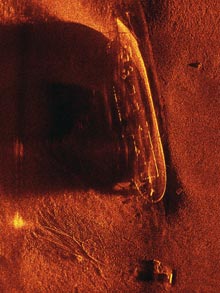During AUVfest 2008, maritime archaeologists (from left) Tane Casserley, Charlotte Taylor, Rod Mather, and Kelly Gleason discuss autonomous underwater vehicle (AUV) data in the Integrated Display Center (IDC). Click image for larger view and image credit.
The Maritime Archaeology Workshop
May 19, 2008
Kerry Lynch
Archaeologist
University of Massachusetts
Archaeological Services and Rhode Island Marine Archaeology Project
Today's autonomous underwater vehicle (AUV) and maritime archaeology workshop was an opportunity for all of us involved in the past week’s demonstrations to sit down together in one room and discuss the applicability and incorporation of AUVs in underwater archaeology. I believe all of us present would agree that the cooperation among archaeologists, technicians, and Navy agencies was a success. Judging from the presentations and discussion during this workshop, I think the archaeologists learned a great deal about how AUV technology can assist us in "seeing" submerged cultural resources. The technicians learned what we need to see, where we need to see, and why we need to see it. And agencies such as the Office of Naval Research (ONR), Naval Undersea Warfare Center (NUWC), and NOAA learned that partnerships and dialog among all these diverse professions are rewarding and useful.
We discussed, and fortunately agreed, that AUVs will not put us out of business. These are tools to be used by archaeologists, not replacements for them. We also discussed the different applications of AUVs. There are individual technologies that are appropriate for the various phases of archaeology, including survey and discovery, site assessment, and regional and site management. For example, the SAS-12 returns extraordinary sonar images, suitable for survey and discovery, that don’t require a background in sonar technology to recognize! The buried object scanning sonar (BOSS) and small synthetic aperture minehunter (SSAM) have the additional benefit of penetrating into the bottom sediment, which is useful to identify buried artifacts and structure. The hovering autonomous vehicle (HAUV) and Transphibian are highly maneuverable and have the ability to hover above or alongside archaeological sites. Their imaging capabilities are also extraordinary and would help facilitate site identification, mapping, and long-term management.
We also discussed the applicability to varied geophysical terrains as well as which technologies are relevant for our different organizational needs. The archaeologists present represented both federal and state management agencies, academia, independent research associations, and cultural resource management firms. Such a wide range of applications will serve to broaden our understanding of just how lucrative these partnerships can be. AUVs generate data useful in locating and examining archaeological sites. An archaeologist’s job is to then make sense of this data for the benefit of the public. We are all responsible, as members of this public, for the stewardship of cultural resources and cultural heritage. We all benefit from increasing our knowledge of this cultural heritage, be it at the local, national or global level.
The discussion at this workshop could have continued for hours, and I personally hope that this is just the beginning of future partnerships and collaborative efforts to "see" and manage our shared legacy.
Sign up for the Ocean Explorer E-mail Update List.


















